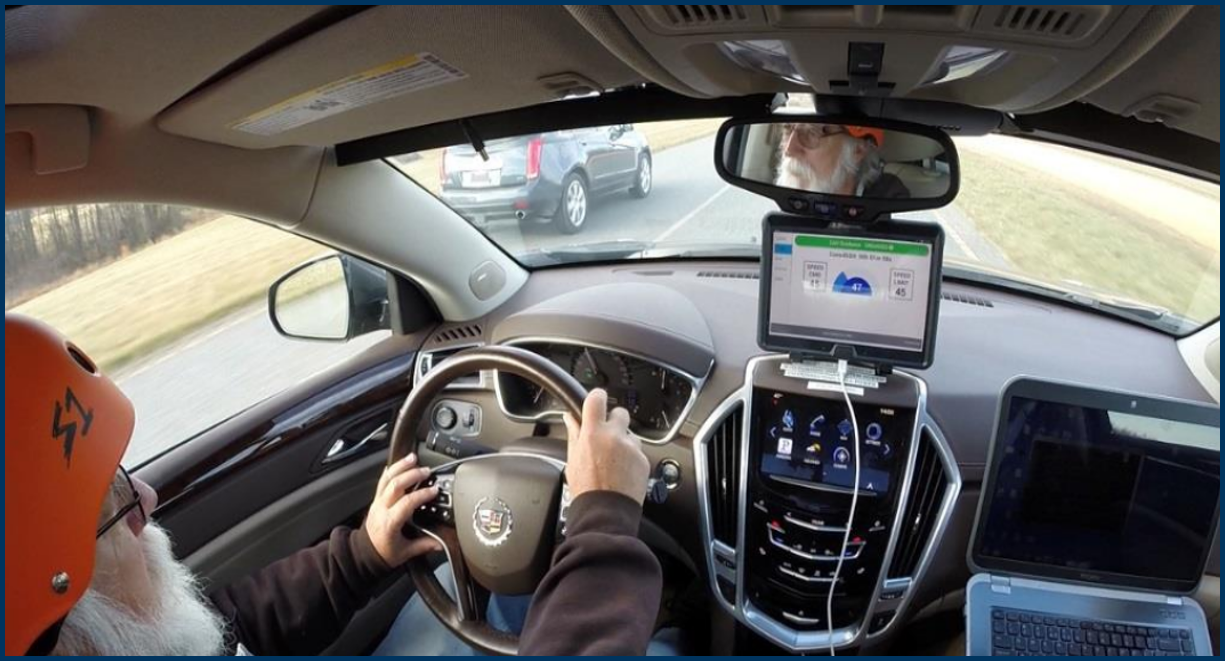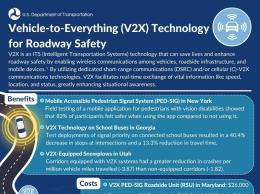Advanced Driver Assistance Systems (ADAS): Cooperative Adaptive Cruise Control (CACC)
2019 Executive Briefing
BRIEFING HIGHLIGHTS:
- Advanced driver assistance systems including cooperative adaptive cruise control (CACC) may reduce congestion, reduce emissions, and improve safety.
- Adaptive cruise control technology can add between $300 to $10,800 to the price of a new vehicle, with a median cost of $4,500. However, as technology progresses, the cost of ACC will continue to decrease.
- The understanding of different adaptive and cooperative adaptive cruise control technologies is increasing and data are available for anyone to study.
Introduction
Advanced driver-assistance systems (ADAS) are developed and deployed to help drivers operate in a safer, more efficient, or environmentally-sound manner. These technologies include those drivers can buy in new vehicles today, such as lane keeping assist and adaptive cruise control, and those still in the research and development phase, such as truck platooning [1].
Congestion in and along roadways are common in both urban and rural areas and ADAS technologies can provide drivers with information to help them more efficiently navigate these conditions without intensifying them. One solution increasingly available in new vehicles is adaptive cruise control (ACC). Controlling traffic speeds on freeways or arterials would have positive impacts on the performance of the roadway, mobility, throughput, increased efficiency and fuel consumption. More advanced versions of this type of technology could use connected vehicle (CV) technologies to set dynamic speed limits via connectivity from roadside infrastructure, whether that be by using dedicated short-range communications (DSRC) technologies or cellular [1].
FHWA is conducting research to measure the efficiency and safety benefits of augmenting automated vehicle capabilities with connected vehicle technologies to enable cooperative automation. Cooperative automation allows automated vehicles to communicate with other vehicles and the infrastructure to coordinate movements and increase efficiency and safety. It uses a range of automation capabilities, including automation technologies at SAE Level 1 and Level 2 [2].
Communications with other vehicles on the roadway, infrastructure, and potentially traffic management centers to harmonize traffic flow could be possible. Future iterations of this technology could include vehicular platooning via cooperative adaptive cruise control (CACC), further increasing the efficiency of roadways, while also reducing aerodynamic drag. Platooning relies on vehicle-to-vehicle (V2V) communication that allows vehicles to accelerate or brake with minimal lag to maintain the platoon with the lead vehicle. Reduced drag would yield reduced fuel consumption, greater fuel efficiency and increased traffic flow, while reducing environmental impacts [1]. Widespread deployment of vehicles equipped with these technologies could greatly increase mobility, decrease environmental impacts, and increase safety [1].
| Deployment of vehicles equipped with ADAS technologies could greatly increase mobility, decrease environmental impacts, and with the continuing development of better autonomous vehicle controls, increase safety. |
A closely related concept to CACC is eco-driving. Eco-driving aims to change driver patterns and styles to reduce fuel consumption and emissions. When used in combination with in-vehicle communications, customized real-time driving advice can be given to drivers so they can adjust their driving behavior to save fuel and reduce emissions. This advice includes recommended driving speeds and optimal acceleration/deceleration profiles based on prevailing traffic conditions and interactions with nearby vehicles. Feedback may be provided to drivers on their driving behavior to encourage driving in a more environmentally efficient manner. Vehicle-assisted strategies where the vehicle automatically implements the eco-driving strategy, such as ACC and platooning, can make eco-driving easier for the driver [3].
Benefits
Multiple U.S. Department of Transportation studies and demonstrations, as well as studies by other government agencies and academia have demonstrated the positive environmental, safety, efficiency benefits of ADAS technologies. Selected benefits information can be found in the following table.
| Selected Benefits |
|---|
| Connected eco-driving for drayage operations on signalized networks can reduce diesel truck energy consumption by 4.4 to 8.1 percent (2018-01325). |
| Field testing and evaluation of GlidePath Cooperative Adaptive Cruise Control (CACC) systems installed on partially automated vehicles show these systems can improve fuel economy by 17 to 22 percent and reduce travel time up to 64 percent (2017-01173, 2017-01203). |
| Eco-Cooperative Adaptive Cruise Control field test yielded fuel consumption reduction of 37.4 percent and travel time reduction of 8.6 percent (2018-01260). |
| A simulation analysis demonstrated that connected vehicles using intersection SPaT data and Eco-Cooperative Adaptive Cruise Control algorithms to regulate speed profiles can reduce fuel consumption up to 40 percent on signalized arterials (2018-01241). |
Costs
Costs for in-vehicle systems change rapidly due to nearly constant technological advancement. ACC is becoming mainstreamed and being offered in multiple models and ranges of vehicles available on the U.S. market. These vehicles use a combination of cameras, radar, and laser components to determine speed and vehicular distance. According to 2017 cost data, ACC can add between $300 to $10,800 to the price of a new vehicle, with a median cost of $4,500 (2017-00373). It is expected, however, that as technology progresses, the cost of ACC will continue to decrease.
Case Study
Test of CACC-based platooning using the USDOT’s Cooperative Automated Research Mobility Applications (CARMA) Platform
| The data collected from this study is available for anyone to review via the USDOT’s ITS DataHub: https://www.its.dot.gov/data/ |
The Federal Highway Administration’s Turner Fairbank Highway Research Center (TFHRC), in conjunction with the Volpe National Transportation Systems Center, tested and evaluated a proof-of-concept CACC-based vehicle platooning system in 2016. Researchers in the Saxton Transportation Operations Laboratory at TFHRC designed and built the CARMA software platform that enables the implementation of the proof-of-concept CACC-based platooning in passenger vehicles equipped with production adaptive cruise control, and vehicle-to-vehicle communications using dedicated short-range communications (DSRC). A summary of initial findings from the proof-of-concept are documented in Test and Evaluation of Vehicle Platooning Proof-of-Concept Based on Cooperative Adaptive Cruise Control [4].
Methodology

Detailed test procedures were described for four fundamental platooning functions: platoon formation, constant time gap with varying speeds, constant speed with varying time gaps, and platoon dissolution. In testing the platooning proof-of-concept, these procedures were applied to three different types of platooning modes: ACC-only in the lead vehicle (LV) and following vehicles (FVs), hybrid CACC in LV and ACC in FVs, and CACC-only in LV and FVs. Tests were conducted by professional drivers on a closed track at the U.S. Army’s Aberdeen Test Center in Maryland. Test data were separated into sets linked to test date and time, and test run number. The data include performance parameters collected from the CACC application and data acquisition systems, including vehicle controller area network data, CARMA's MicroAutoBox, DSRC radios, and an independent measurement system.
Findings
The following results are observed for various car platooning performance measures, based on the July 2016 characterization testing of the proof-of-concept:
- FVs in ACC and CACC modes maintain stable time gaps while at constant speed but are less stable during speed changes.
- FVs in ACC and CACC modes maintain stable speeds while at constant speed. During deceleration, the difference between the LV’s and each FV’s speeds generally increases toward the end of the platoon. During acceleration, the speed of the FVs in CACC mode appears stable while it is slightly less stable in ACC mode.
- While CACC is generally more stable during deceleration and acceleration, there is more variation between the minimum and maximum CACC speeds versus ACC where the minimum and maximum values are quite close.
- FVs in neither ACC nor CACC mode maintain stable initial response delays during deceleration. FVs in ACC mode are similarly unstable during acceleration, but FVs in CACC mode appear stable, with short initial response delays.
- FVs in ACC and CACC modes exhibit similarly poor settling durations following transient periods. FVs in CACC achieve the ±5% following speed trend sooner that FVs in ACC, while FVs in CACC take longer to achieve the 0% following speed trend. The data from this study are available through the U.S. Department of Transportation’s ITS DataHub [5].
The Evolution of CARMA
CARMA started in 2014 for the development and implementation of the initial proof of concept software platform, CARMA1. In 2018, the latest version CARMA2, migrated to a Robot Operating System (ROS) architecture, available on GitHub. Currently, the CARMA2 software platform has plug-ins supporting the following cooperative driving tactics [6]: Cruising—Recognize and follow speed limit. Yield—Slow down vehicle to avoid a collision. Lane change and merge—Coordinate with vehicle in a lane to the left or right to make space to merge and change lanes. Platooning—Enable collaboration between vehicles at close range in a single lane to save fuel and reduce roadway usage. Speed harmonization—Follow dynamic speed commands from a cloud server that is measuring traffic and determining upstream speeds to minimize traffic jams and limit back-end congestion.
The development of CARMA3 kicked off in August 2018 and will be developed in the open using agile software development [6].
References
- “Driver Assistance Technologies.” National Highway Traffic Safety Administration website. https://www.nhtsa.gov/equipment/driver-assistance-technologies
- Preparing for the Future of Transportation: Automated Vehicles 3.0 (AV 3.0), USDOT, October 2018, https://www.transportation.gov/sites/dot.gov/files/docs/policy-initiatives/automated-vehicles/320711/preparing-future-transportation-automated-vehicle-30.pdf
- Yelchuru, B. et al. AERIS - Applications for the Environment: Real-time Information Synthesis : Eco-lanes Operational Scenario Modeling Report. ITS Joint Program Office, USDOT, December 2014. https://rosap.ntl.bts.gov/view/dot/3536
- Tiernan, T. et al. Test and Evaluation of Vehicle Platooning Proof-of-Concept Based on Cooperative Adaptive Cruise Control. John A. Volpe National Transportation Systems Center, USDOT, April 2017. https://connectedautomateddriving.eu/wp-content/uploads/2017/08/2017-06-30_USDOT_CAAC-Platooning_Final_Report_170630.pdf
- Test Data of Proof-of-Concept Vehicle Platooning Based on Cooperative Adaptive Cruise Control (CACC). ITS Joint Program Office, USDOT, November 9, 2018. https://data.transportation.gov/Automobiles/Test-Data-of-Proof-of-Concept-Vehicle-Platooning-B/wpek-zziu/
- “Cooperative Automation Research Mobility Applications (CARMA) Open Platform.” FHWA website. https://highways.dot.gov/research/research-programs/operations/CARMA/design-and-architecture


